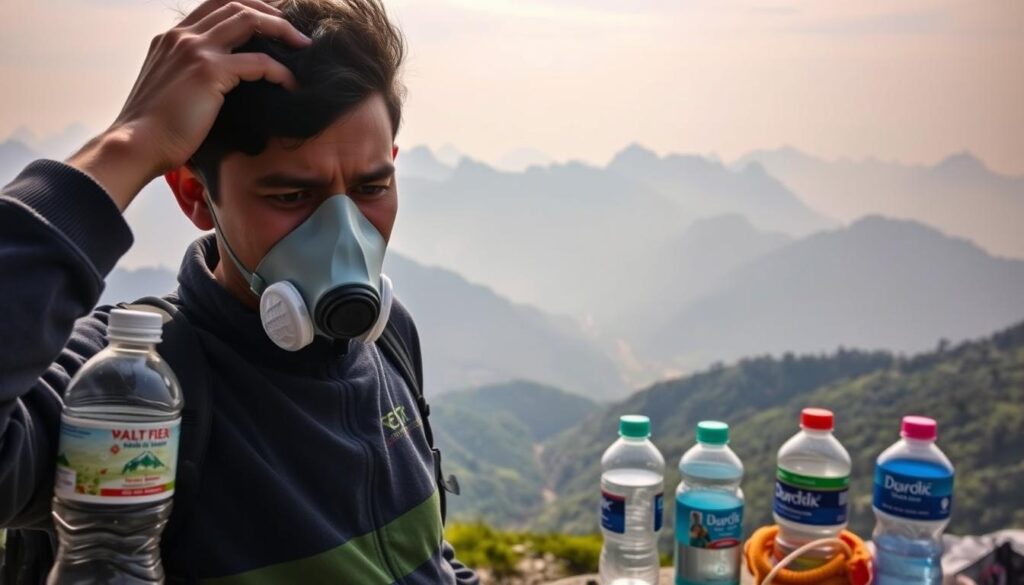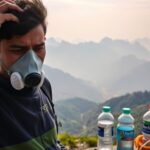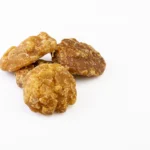Exploring the Himalayas or trekking in India’s high-altitude areas is thrilling. But, it also brings the risk of mountain sickness, or acute mountain sickness (AMS). This condition can hit climbers, hikers, skiers, or travelers at high altitudes, usually over 8000 feet (2400 meters)1. The main cause is lower air pressure and oxygen levels at high altitudes, leading to serious symptoms.
It’s key to know the causes, symptoms, and how to prevent mountain sickness in India. By understanding the risks and taking steps to avoid them, we can have a safer and more fun time outdoors.
Key Takeaways:
- Acute mountain sickness is a common condition that affects individuals at altitudes above 8,000 feet (2,400 meters).
- Rapid ascent to high altitudes significantly increases the risk of developing acute mountain sickness.
- People living at or near sea level are more susceptible to acute mountain sickness when traveling to high-altitude regions.
- Recognizing the early symptoms of acute mountain sickness, such as headache, fatigue, and nausea, is crucial for timely treatment and prevention.
- Proper acclimatization, gradual ascent, and the use of preventive medications can help mitigate the risk of mountain sickness in India.
Understanding Acute Mountain Sickness (AMS)
Acute Mountain Sickness (AMS) happens when people go to high places, usually over 2,500 meters (about 8,000 feet)2. It’s caused by less air pressure and oxygen at high altitudes. This makes it hard for the body to adjust.
What is Acute Mountain Sickness?
AMS shows as headaches that don’t go away and other symptoms like nausea and tiredness3. It can be mild or severe. Mild AMS might just make you feel a bit off, while severe can make you very sick.
Causes of Acute Mountain Sickness
Things that make AMS riskier include going up too fast and being more sensitive to altitude2. Being overweight or having migraines also raises your risk3. Not drinking enough water can make symptoms worse because it makes it harder for your body to adjust2.
AMS and other altitude sicknesses are linked to how our bodies react to less oxygen3. Knowing what causes AMS helps us stay safe when we’re in high places.
Symptoms of Mountain Sickness in India
When you’re trekking or climbing high in India, knowing the signs of mountain sickness is key. This condition, also known as Acute Mountain Sickness (AMS), can show up in different ways. You might feel a severe headache, extreme tiredness, or get dizzy and lightheaded. You could also feel sick to your stomach, lose your appetite, or have trouble sleeping4.
As you go higher, the air pressure drops, and there’s less oxygen. This imbalance can cause AMS symptoms4.
- At sea level, the air has about 21% oxygen. But this number goes down to below 15% at 3000 meters. It halves compared to sea level at 5000 meters4.
- Going up too fast without getting used to the altitude can make this imbalance worse. This can lead to AMS4.
In serious cases, you might see blue skin, feel tightness in your chest, or get confused. You could cough up blood or find it hard to walk4. These signs could mean you’re facing a serious problem, like High Altitude Pulmonary Edema (HAPE) or High Altitude Cerebral Edema (HACE)4.
To figure out if you have AMS, a doctor might use a pulse oximeter. If your blood oxygen level is more than 10 points lower than others at the same height, you might have AMS4.
“Experiencing the symptoms of mountain sickness can be a daunting and potentially dangerous situation, but with proper knowledge and preparation, it can be managed effectively.”
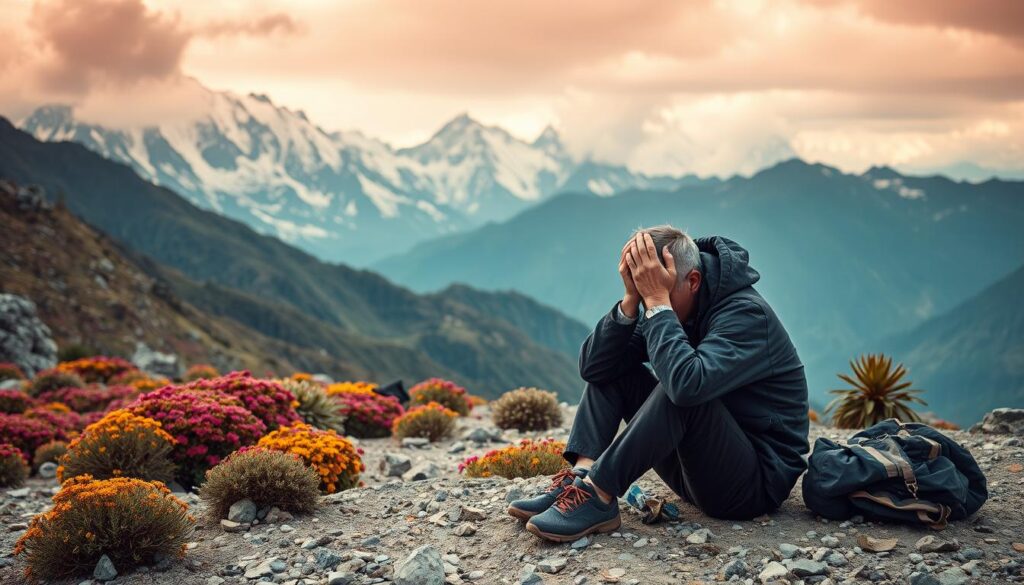
Risk Factors for Developing AMS
Acute Mountain Sickness (AMS) is a serious concern for those exploring high-altitude areas in India. Several key risk factors can increase the chance of getting this condition5.
Rapid Ascent
One major risk factor is rapid ascent. People who go up high too fast without acclimatizing face a higher risk of AMS6. Studies found that climbing to 3,140 m, 4,300 m, and 5,276 m increases this risk6.
Individual Susceptibility
Another key factor is individual susceptibility. Some people are more likely to get AMS, no matter their fitness or experience5. Pre-existing conditions like respiratory or cardiovascular disorders can also raise the risk of severe altitude sickness2.
High Altitude Exposure
The degree of high-altitude exposure also matters. Altitudes over 2,500 meters (about 8,000 feet) are considered high, and AMS risk grows with elevation5. As people go higher, they may feel more hostility, depression, and anxiety6.
It’s crucial for those planning high-altitude adventures in India to know these risks. They should take steps to avoid getting Acute Mountain Sickness.
Complications of Untreated Mountain Sickness
Acute mountain sickness (AMS) is a serious issue that happens when people go too high too fast. If not treated, it can cause severe problems like high altitude pulmonary edema (HAPE) and high altitude cerebral edema (HACE)57.
High Altitude Pulmonary Edema (HAPE)
HAPE makes it hard to breathe because fluid builds up in the lungs. It’s a severe problem that can be deadly. In fact, HAPE can kill up to 50% of people if not treated7.
High Altitude Cerebral Edema (HACE)
HACE is when fluid in the brain causes headaches, loss of balance, and trouble speaking. It can even lead to seizures and loss of consciousness. It’s a very dangerous condition7.
It’s important to know the signs of AMS and get help right away if they get worse. Treatment, like going down to lower altitudes, using oxygen, and taking medicine, can prevent these serious problems57.
Some people are more at risk for AMS, like those going too high too fast, being overweight, or having migraines. They should be careful and take steps to avoid these serious issues5.
| Complication | Description | Potential Impact |
|---|---|---|
| High Altitude Pulmonary Edema (HAPE) | Fluid accumulation in the lungs, leading to difficulty breathing | Potentially fatal, with mortality rates up to 50% if left untreated |
| High Altitude Cerebral Edema (HACE) | Fluid buildup in the brain, causing severe headaches, loss of coordination, and potential loss of consciousness | Severe and potentially fatal condition associated with high altitude illness |
People planning to visit high places in India should know about the dangers of untreated mountain sickness. They should take steps to stay safe and healthy57.
Diagnosis and Treatment of AMS
It’s important to know how to handle acute mountain sickness (AMS) when you’re at high altitudes. The best thing to do is to go down to a lower place as fast and safely as you can8. This helps your body get used to the change in altitude and feel better.
Using oxygen can also help if you have AMS9. There are medicines like acetazolamide (Diamox), nifedipine, and dexamethasone that can help with the symptoms. But, going down to a lower altitude is still the most important thing to do.
Descending to Lower Altitudes
Going down to a lower place is the best way to get rid of AMS symptoms. Try not to go up more than 1,000 feet (300 meters) a day once you’re above 8,000 feet to avoid getting sick8. It’s also good to spend a few days at middle altitudes before going higher, especially above 10,000 feet8.
Oxygen Supplementation
Oxygen can be a big help when you have AMS. It makes it easier for your body to adjust to the less oxygen at high places9. In very bad cases, like HACE or HAPE, oxygen is very important to keep you safe while you go down.
Medication for AMS
Some medicines can help with AMS symptoms, but they’re not a replacement for going down to a lower place. Acetazolamide (Diamox) helps your body get used to the altitude faster8. Dexamethasone is used for severe AMS, HACE, and HAPE to reduce swelling in the brain and lungs9. Nifedipine helps with HAPE by easing lung pressure9. Aspirin and ibuprofen can help with headaches from altitude sickness9.
It’s key to know the signs of AMS and what to do about them to have a safe and fun time at high altitudes. Knowing how to diagnose and treat AMS helps travelers in India get ready for and deal with the challenges of mountain adventures.
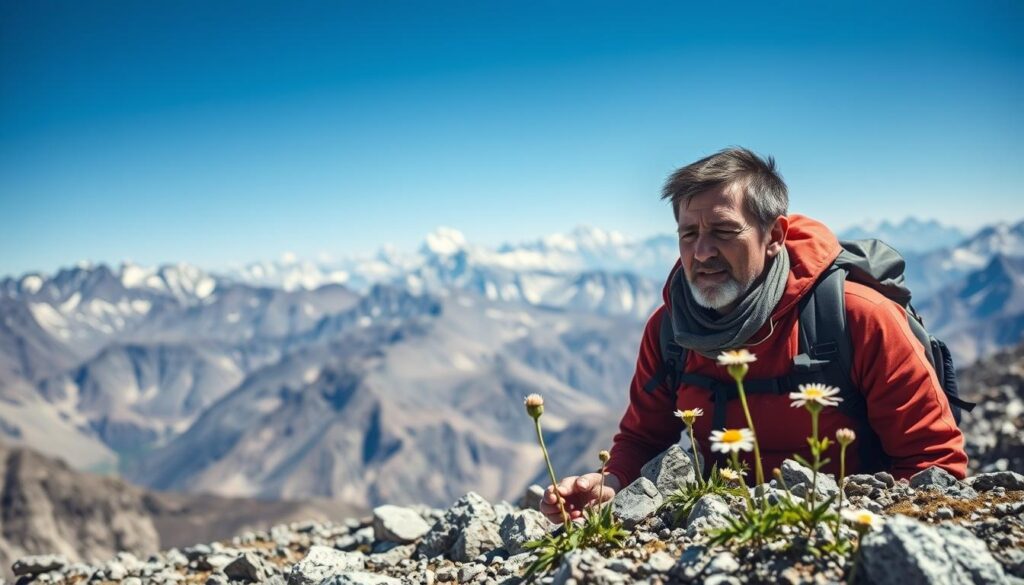
Prevention Strategies for Mountain Sickness in India
Exploring the Indian Himalayas needs careful planning to stay safe and have fun. It’s important to fight against mountain sickness, like acute mountain sickness (AMS). Luckily, there are ways to lessen the risk of altitude sickness.
Gradual Ascent and Acclimatization
Slowly climbing up and letting your body adjust to the thin air is key10. Stay overnight for every 1,000 feet or 305 meters after reaching 10,000 feet. Rest for a full day after every 3,000 feet or 915 meters increase10. Rushing up can lead to AMS, so go slow.
Proper Hydration
Drinking enough water is vital to avoid mountain sickness10. Drink lots of water, milk tea, juice, and soup10. Avoid tobacco, smoking, alcohol, and depressant drugs at high altitudes10.
Medications for Prevention
Healthcare providers might suggest taking acetazolamide (Diamox) to help adjust10. These meds can ease AMS symptoms, making it easier to adapt to high altitudes10. Using oxygen cylinders can also help, but only with a doctor’s advice10.
Using these prevention methods can make your high-altitude trips safer and more fun in the Indian Himalayas.
“Proper preparation and prevention are the keys to conquering the challenges of high-altitude trekking in India.”
mountain sickness in india: Guidelines for Indian Trekkers
Indian trekkers and mountaineers face risks of mountain sickness at high altitudes. It’s vital to follow guidelines for safety11. The Indian Mountaineering Foundation offers key advice for safe and successful treks, especially to Everest Base Camp.
One important rule is to not climb too high each day. Aim for 300-500 vertical meters above 3,000 meters11. The ‘climb high, sleep low’ method helps avoid altitude sickness. This means descending to a lower altitude for rest11.
Rest days are crucial for adjusting to altitude changes11. Drinking 3-4 liters of water daily is essential, more in hot weather11. Trekking with a partner is wise for support and quick help in emergencies11.
Carrying a satellite phone or two-way radio is smart for staying in touch in remote spots11. Pack light, nutritious snacks like fruits, nuts, and energy bars for energy11. Wear layers, including waterproof and windproof clothes, to manage temperature11. Trekking poles help with stability and reduce knee strain on uneven paths11.
By adhering to the Indian Mountaineering Foundation’s guidelines, trekkers can reduce altitude sickness risks. This ensures a safe and enjoyable high-altitude adventure111213.
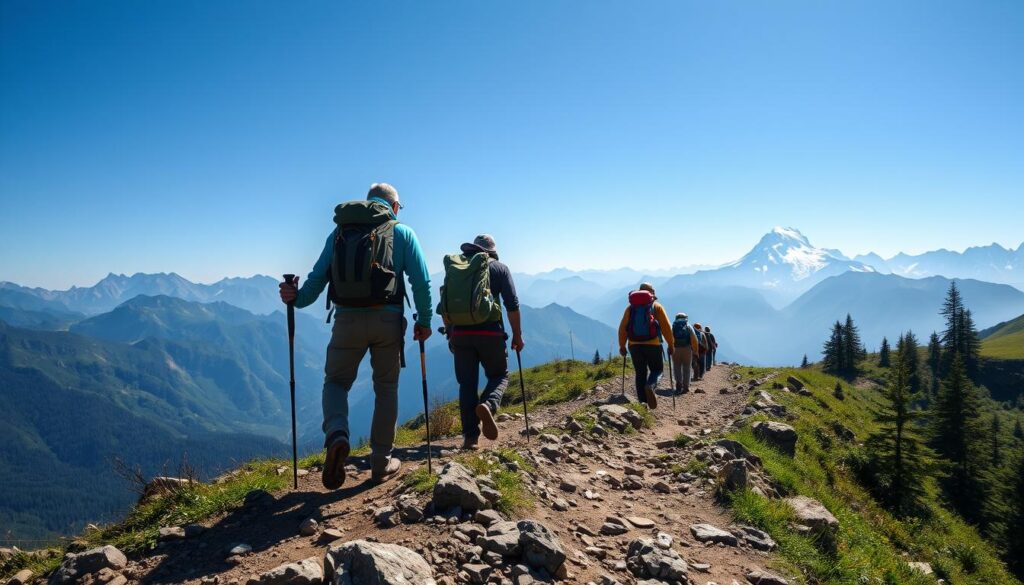
Emergency Management and Evacuation
Severe mountain sickness, like HAPE or HACE, needs quick medical help and moving to a lower place14. This might mean using a portable hyperbaric chamber, like the Gamow bag, or giving medicines like acetazolamide and dexamethasone14.
Altitude sickness gets worse with higher altitudes. High altitudes are 4,950 to 11,500 feet, very high is 11,500 to 18,000 feet, and extreme is over 18,000 feet14. Symptoms of AMS include headaches and feeling tired. HAPE and HACE are more serious, with breathing problems and confusion14.
Going down is the best way to treat altitude sickness. Over-the-counter pain relievers can help with headaches14. But, a portable hyperbaric chamber, like the Gamow bag, is key for emergency relief14.
To avoid altitude sickness, climb slowly and rest at new heights. Avoid alcohol and sedatives14. Medicines like acetazolamide and dexamethasone can help prevent and treat it, but not coca leaves14.
Children face special challenges with altitude sickness. It’s hard to spot in kids under 3, and they get cold faster15. Plan a slow climb with rest days, especially at high altitudes15.
More people are climbing mountains, with a 30% jump in Everest permits in 202416. This means we need better emergency plans for problems like HAPE and frostbite16.
Rescues in the mountains are tough. Weather changes fast, and avalanches are a big risk16. Global Rescue now offers more help in these tough places16.
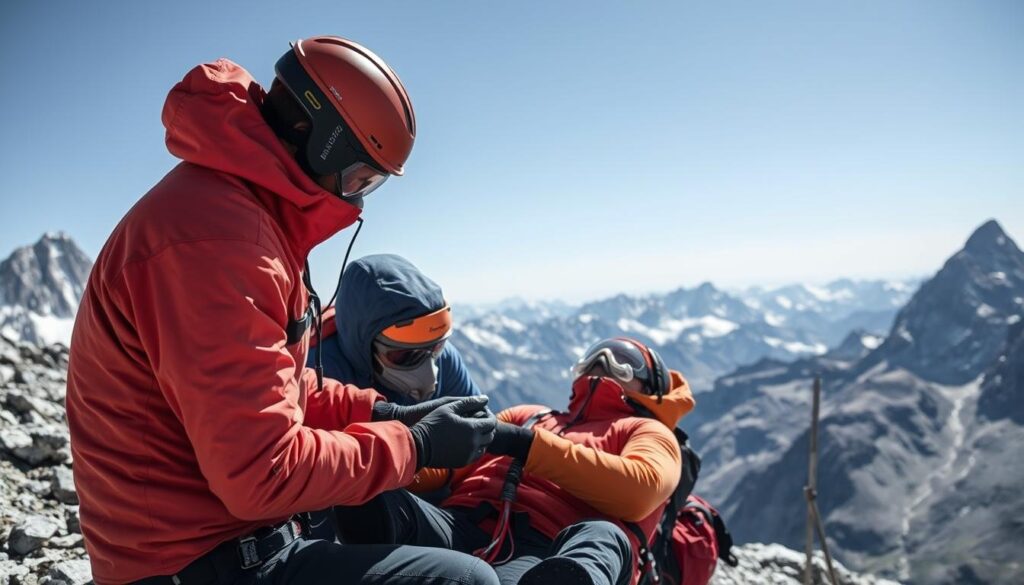
“Immediate descent is the definitive treatment for altitude sickness, and over-the-counter medications like aspirin or ibuprofen can help with headaches.”
Conclusion
Understanding symptoms, causes, and prevention of mountain sickness in India is key17. It helps us prepare for high-altitude adventures safely. We must ascend gradually, stay hydrated, and watch for early signs of AMS1.
Historical accounts17 and recent studies6 give us a full picture of mountain sickness in India. This knowledge helps us create safe strategies for ourselves and others. It makes our high-altitude journeys safe and memorable.
Remembering to acclimatize, stay hydrated, and watch for AMS symptoms is crucial1. By focusing on our safety, we can enjoy India’s high-altitude beauty. We create unforgettable experiences that inspire others to explore these landscapes.
FAQ
What is Acute Mountain Sickness (AMS)?
What are the symptoms of Acute Mountain Sickness?
What are the risk factors for developing Acute Mountain Sickness?
What are the complications of untreated Acute Mountain Sickness?
How is Acute Mountain Sickness treated?
How can Acute Mountain Sickness be prevented in India?
What guidelines do Indian trekkers and mountaineers need to follow?
How is severe mountain sickness managed in emergencies?
Source Links
- Acute mountain sickness: MedlinePlus Medical Encyclopedia – https://medlineplus.gov/ency/article/000133.htm
- A Guide To AMS, HAPE and HACE Prevention For High-altitude Trekking – https://trekthehimalayas.com/high-altitude-trek-health-prevent-ams-hape-hace
- Frontiers | Recent advances in predicting acute mountain sickness: from multidimensional cohort studies to cutting-edge model applications – https://www.frontiersin.org/journals/physiology/articles/10.3389/fphys.2024.1397280/full
- AMS during trekking: Preventive measures and treatment | HT – https://himalayatrekker.com/safety/acute-mountain-sickness-during-trekking-precautions-prevention-treatment/
- Recent advances in predicting acute mountain sickness: from multidimensional cohort studies to cutting-edge model applications – https://www.ncbi.nlm.nih.gov/pmc/articles/PMC11228308/
- Acute mountain sickness predicts the emotional state of amateur mountaineers – Scientific Reports – https://www.nature.com/articles/s41598-024-55291-3
- Altitude Sickness – http://www.nwcg.gov/6mfs/firefighter-health-first-aid/altitude-sickness
- Altitude Sickness: Symptoms, Treatment, and Home Remedies – https://www.medicoverhospitals.in/diseases/altitude-sickness/
- High Altitude Sickness During Kailash Mansarovar Yatra – https://www.kailash-yatra.org/blog/high-altitude-sickness-causes-symptoms-and-cure.html
- 12 Tips to Prevent AMS in Ladakh – Spiti – Zanskar Trips [Acute Mountain Sickness] – https://discoverwithdheeraj.com/acute-mountain-sickness-and-importance-of-acclimatization/
- Safety measures during a trek – Himalaya Shelter – https://himalayashelter.com/blogs/safety-measures-during-a-trek/
- Diamox: The Acute Mountain Sickness (AMS) Solution – https://www.trekupindia.com/diamox-the-acute-mountain-sickness-ams-solution
- Acute Mountain Sickness – High Altitude Trekking | Medication to Learn before Trek – https://mosaicadventure.com/acute-mountain-sickness-high-altitude-trekking/
- Altitude Sickness: What Every Traveler Needs to Know – https://www.worldnomads.com/travel-wiser/wellness/how-to-deal-with-altitude-sickness
- Acute Mountain Sickness: Causes,Symptoms & Diagnosis – Motherhood Chaitanya Hospital – https://www.motherhoodchaitanya.com/acute-mountain-sickness/
- Saving High-Altitude Climbers – Global Rescue – https://www.globalrescue.com/common/blog/detail/high-altitude-mountain-climbing-rescue-experts/
- Mountain sickness: neurologic aspects | MedLink Neurology – https://www.medlink.com/articles/mountain-sickness-neurologic-aspects

